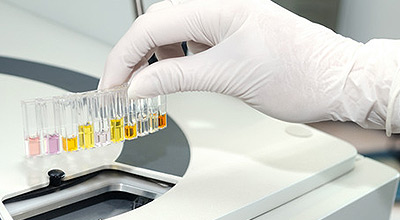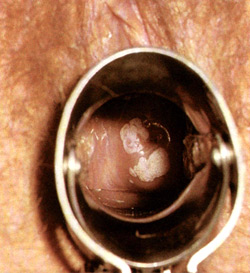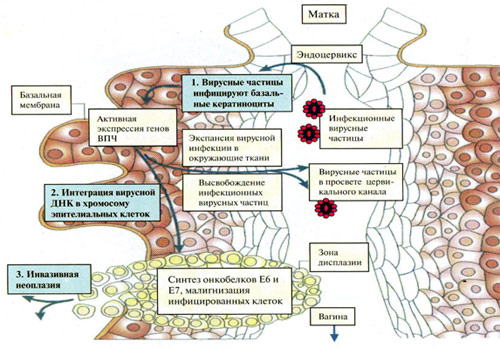Uterine neck dysplasia (erosion)All the information contained on this informational resource is intended exclusively for practitioners and cannot be used by the site visitors for self-diagnosing and prescribing treatment without a previous consultation with the doctor.
The background of Uterine Cervical Dysplasia.
Currently, the HPV infection in people of biologically active age is between 20-60% (Ludicke F. et al., 2001). The information of the centre for infectious disease control (Atlanta, the USA) indicates that about 630 million people worldwide and 20 million Americans suffer with genital warts and HPV occurs 3 times more often than GH (Genital Herpes) and not less than gonorrhea (D. K. Ermolenko, V. A. Isakov, 2003). The frequency of cervical papillomavirus lesions (cervical erosion, dysplasia, cervical leukoplakia) is much more higher in sexually active women younger than 25 years. Papillomaviruses is the only group of viruses for which it has been proved that in vivo they induce the tumor formations in humans..
A combined persistence of HPV with HSV-2, CMV, EBV, HIV, chlamydia and mycoplasma is adverse. The average age of patients with carcinoma in situ is 29 years, i.e., it takes approximately 10 years from time of initial infection until the appearance of severe neoplasia. An invasive cancer is detected at the age of 49 years, when there are additional changes in the immune system which result in invasion and metastasis (V. N. Prilepskaya and others, 2007; N. R. Safronnikova, V. M. Merabishvili, 2005). More than 70% of cervical cancer cases have associated with HPV of 16 and 18 types (A guide for doctors "Application of Allokin-alpha in the treatment of viral infections" F. I. Ershov, V. A. Isakov, G. P. Becker, M. Y. Serebryakov, T. V. Sologub, N. B. Serebryanaya, M. S. Tischenko, S. I. Chernysh 2008, p. 77). Despite the organized screening programs using Papanicolaou test (Pap-test), approximately 35,000 women died from this disease in the USA and Europe. Last time about 20 types of HPV are attributed with cancer of the cervical canal (95%) (A guide for doctors "Application of Allokin-alpha in the treatment of viral infections" F. I. Ershov, V. A. Isakov, G. P. Becker, M. Y. Serebryakov, T. V. Sologub, N. B. Serebryanaya, M. S. Tischenko, S. I. Chernysh 2008, p. 78). According to V. I. Kozlova et al. (2003) mostly the urogenital tract is diseased with HPV-6, 11, 16, 18, 31, 35 types (see table). According to the ability of HPV to induce neoplastic processes they are subdivided into: low (3, 6, 11, 13, 32, 34, 40, 41, 42, 43, 44, 51, 61, 72, 73 type), medium (30, 35, 45, 52, 53, 56, 58) and high (16, 18, 31, 33, 39, 50, 59, 64, 68, 70) cancer risk (V. I. Kozlova, A. F. Pukhner, 2003; N. M. Shakhova and others, 2006; Lorincz AT et al., 1992). HPV-16 (50%) and HPV 18 (10%) are more frequent among all, therefore women with confirmed genital HPV lesions of the cervix (cervical erosion, dysplasia, leukoplakia, cervical intraepithelial neoplasia) have to consult annually the gynecologist having a colposcopy, cytological examination of cervical smears, virological and immunological examination. It is considered, that in a certain percentage of cases with human papillomavirus infection (PVI) the virus can be excreted from the women's bodies spontaneously (N. R. Safronnikova, V. M. Merabishvili, 2006). An important step in the prevention of cervical erosion and malignant neoplasm of the cervix is early diagnosis and effective treatment of cervical lesions with human papillomavirus. The lack of treatment or incorrect treatment of patients with human papillomavirus infection leads to the development of cervical erosion. A malignancy erosive process is possible at further progress of the disease (or the source of infection, which visually may not manifest as an erosion), and therefore the development of dysplasia and cervical cancer. Lesions mainly of the urogenital tract with
Read more:
Ask your gynecologist if he (she) has an experience in treatment of human papillomavirus infection to the complete removal of human papilloma virus from the body? |
|
| Homepage | Feedback | Site Map | Job Vacancies | Contacts
© 2004—2020 Brand-Pharm Ltd. All information contained on this website is intended only for medical specialists and cannot be used by visitors for self-diagnosis and treatment. Consult your physician, do not start self-medication!
The website creation and promotion: Alisa Design |






 According to the WHO the Human Papillomavirus is the main cause for the progress of cervical erosive lesions, and also dysplasia and malignancies of cervical epithelium. The virus in this pathology is detected in almost 100% of cases. In the evaluation of cervical cancer cases and deaths all over the world during 2002, it has been detected, that the persistent HPV infection was a cause of cervical cancer in about 500,000 cases
According to the WHO the Human Papillomavirus is the main cause for the progress of cervical erosive lesions, and also dysplasia and malignancies of cervical epithelium. The virus in this pathology is detected in almost 100% of cases. In the evaluation of cervical cancer cases and deaths all over the world during 2002, it has been detected, that the persistent HPV infection was a cause of cervical cancer in about 500,000 cases 
